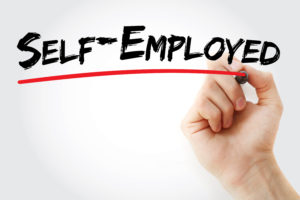Contents
CHAPTER 13 BANKRUPTCY: MONTHLY PAYMENT REQUIRED

Chapter 13 Bankruptcy can be more more challenging for self-employed people.
A Chapter 13 bankruptcy is a “reorganization” or “payment plan” bankruptcy in which you repay some of what you owe to creditors through a 3-5-year payment plan administered by the US Bankruptcy Court.
Chapter 13 is not a “debt consolidation,” however. Although, in some cases, people who file for Chapter 13 bankruptcy do repay 100% of what they owe to their creditors, a larger percentage pay less than they owe and then discharge the remaining balance at the end of the process.
What is repaid depends upon how much the person filing the bankruptcy pays into the Chapter 13 bankruptcy “payment plan” each month relative to what sorts of debt they owe (secured vs. unsecured, etc.) and relative to how much they owe.
To read more about how Chapter 13 bankruptcy works generally, click here.
The focus of this article is the question of how Chapter 13 works for someone who is self-employed or who earns income from sales commissions or other performance-based fees.
How does a Chapter 13 payment plan function when one’s income is not consistent from month-to-month?
THE CHAPTER 13 PAYMENT PLAN: MONTHLY AVERAGE—OF WHAT?
In the Eastern District of Michigan Bankruptcy Court system, the monthly Chapter 13 Plan payment that a person in Chapter 13 bankruptcy pays to the Chapter 13 Trustee assigned to her case is the amount of “net income” left over after all of her necessary average monthly expenses are deducted from her average monthly income.
For a person earning income from wages or an annual salary, it is relatively simply to calculate the average monthly income amount, even if overtime or holiday pay or some sort of bonus complicate the picture somewhat.
If you earn $4,000 per month (gross) every month, therefore, your Plan payment is simply what’s left over after taxes, insurance, and other allowable deduction are made from your wages, with your necessary household expenses (food, transportation, out-of-pocket medical, rent, etc.) further deducted.
If what’s left over $200.00, that’s your Chapter 13 monthly plan payment. If what’s left over is $2,000.00, that’s your monthly Chapter 13 plan payment.
However, if that number varies wildly from month-to-month, it is less simple to calculate—and even less simple to survive the Chapter 13 process, which will require the same payment amount every month, regardless of whether the person in the bankruptcy has had a “good” month or a “bad” month in terms of earnings.
In that case, what is required is a meticulous averaging of 12 full months’ worth of income to calculate a monthly average income—and plan payment—that accounts for the “bad” months anyone who is self-employed or commission-based encounters in addition to the “good” months.
Even then, the future is always unwritten for self-employed persons. What happened in the prior 12 months may not reflect what is likely to happen in the 12 months after filing the Chapter 13 bankruptcy proceeding.
Did you lose a key customer? Has the market shifted on your business? Are there too many cut-rate competitors entering your market now and driving your prices down? (Bankruptcy attorneys are familiar with this phenomenon!)
The income average that feeds into the Chapter 13 plan payment amount is supposed to reflect where your income is the day you file your bankruptcy and what it will be in at least the year after the Chapter 13 is filed.
It is not necessarily anchored to your historical income—but the Chapter 13 Trustees who are assigned to your case by the Bankruptcy Court will presume that it is, however baselessly.
Arguing that your plan payment is correct based upon future earnings potential rather than historical earnings is one more challenge for the self-employed person in Chapter 13 bankruptcy.
SELF-EMPLOYED PEOPLE & CHAPTER 13 BANKRUPTCY: AFTER THE CASE IS APPROVED
So you work with a good bankruptcy attorney, provide good income information to your attorney, an accurate petition and plan is filed, and your payment plan is approved (“confirmed”) by the Bankruptcy Court, what’s the next challenge for the self-employed person?
Making it work. Every month. For 36-60 months.
It’s one thing to do a good job putting the numbers together. It’s another thing to live it and budget properly so that you bank what you need to cover your static, unchanging monthly plan payment every month in the months that the earnings aren’t there.
Even you don’t earn that “monthly average” amount in a given month during your Chapter 13 proceeding, you are still required to make your full monthly plan payment. It is still your responsibility to send in the right amount to the Trustee, regardless of whether you had a “good” month or a “bad” month.
Your challenge is socking away the excess, above-average earnings you receive in the good months so that you can send a full plan payment to the Trustee in the bad months.
This is not easy. But, with discipline and the right filing-timing (during a “good” month, ideally, so that you start out with a comfortable bank balance), it can work and set you on a fixed timeline to living a debt-free life.
SELF-EMPLOYMENT & MICHIGAN CHAPTER 13 BANKRUPTCY: THE BOTTOM LINE
The bottom line is that, if you are self-employed, a business-owner, a sales professional earning commissions, or any other individual drawing income from non-traditional sources, you need to retain an experienced bankruptcy attorney to assist you or your Chapter 13 proceeding is highly unlikely to succeed.
The Law Offices of Walter A. Metzen & Associates offers free consultations for those interested in the bankruptcy process and is experienced in calculating a Chapter 13 payment plan amounts for individuals with variable monthly income amounts.




